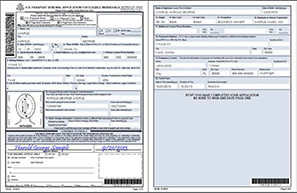5 Ways to Register Your Car Without Paperwork

1. Online Registration Services

The digital transformation of government services has made it easier than ever to register your car without the traditional stacks of paperwork. Many states now offer online car registration services where you can complete the entire process from the comfort of your home.
- Visit your state's DMV website to see if they offer online registration.
- Create an account if you don't already have one, which often requires basic personal information.
- Fill out the necessary forms online, which typically include details about the vehicle like make, model, year, and VIN (Vehicle Identification Number).
- Upload the required documents:
- Proof of insurance
- Current registration (if applicable)
- Any necessary emissions tests
- Pay the registration fees online using a credit or debit card. Some services might accept electronic checks or other forms of online payment.
💡 Note: Be sure to verify that the website is secure (look for HTTPS) to protect your personal and financial information.
2. Mobile Apps

Mobile technology has revolutionized how we manage many aspects of our lives, including car registration. Several states provide mobile apps for vehicle-related services, making it even more convenient to register your car:
- Download the state’s official DMV app from your app store.
- After logging in or registering, navigate to the vehicle registration section.
- Enter your vehicle’s details and upload required documents directly from your phone.
- Use the app to scan and upload physical documents if needed, or connect your digital insurance documents.
- Complete payment through the app's secure payment system.
📱 Note: Always keep your mobile app updated to benefit from the latest security patches and features.
3. Email Submission

If your state or municipality does not yet have an online or mobile system in place, they might still offer a service where you can email your registration forms:
- Download the necessary forms from the state or local DMV website.
- Fill out these forms digitally or scan them if you have physical copies.
- Email the completed forms and any required documents to the designated email address provided by your DMV.
- Be prepared to follow up, as you might need to confirm the receipt or address any issues through email.
📧 Note: Ensure your email attachments are scanned or formatted correctly to prevent delays or rejections by the DMV systems.
4. Kiosk Registration

For those who prefer a more automated but still physical interaction, some DMV offices or public places have installed self-service kiosks. Here’s how to use them:
- Locate a nearby kiosk, often found at grocery stores, libraries, or DMV locations.
- Interact with the kiosk's touch screen, following the on-screen prompts to enter vehicle details.
- Use the kiosk's scanner to submit documents, or if you have physical copies, follow the instructions to scan them in.
- Make your payment through the kiosk, which usually supports various payment methods including cash, debit/credit cards, and possibly mobile wallets.
👨💻 Note: Although these kiosks reduce the need for paperwork, they still require you to carry your documents for scanning or verification.
5. Third-Party Services

If dealing with the DMV directly feels overwhelming, consider utilizing third-party services that specialize in streamlining the car registration process:
- Research reputable companies offering DMV services in your area.
- Choose a service that either provides an online platform or has physical locations where you can handle registration.
- Provide your vehicle information and necessary documents to the service provider, either through their website or in person.
- The third-party will handle the paperwork on your behalf, often simplifying the process and sometimes offering additional services like vehicle history checks or personalized license plates.
- Pay any fees both to the DMV and for the service you've utilized.
💸 Note: While third-party services can save time and hassle, they often come with an additional cost, so factor this into your decision-making.
Car registration has certainly evolved from the days of long lines and piles of paper forms. With options ranging from fully digital processes to utilizing technology like mobile apps and kiosks, registering your car has become significantly more straightforward and less time-consuming. Whether you're tech-savvy or prefer a more traditional approach, there’s now a solution to fit every preference, reducing the frustration associated with government administrative tasks. Embracing these new methods not only simplifies the process for individuals but also represents a shift towards efficiency in public service delivery. Remember, while these systems aim for convenience, staying informed about your state's specific requirements and the status of your registration is essential to maintain compliance and avoid any penalties.
Can I renew my car registration online in all states?

+
No, not all states have online car registration services. Check with your local DMV to see if your state offers this convenient option.
What documents are needed to register a car online?

+
You typically need proof of insurance, the vehicle’s title or current registration, any emissions test results if applicable, and personal identification. Some states might also require a bill of sale if it’s a new purchase.
Is using a third-party service for registration legal?

+
Yes, as long as the third-party service is licensed or authorized to provide these services by your state’s DMV, it is perfectly legal and can be a convenient alternative to handling the process yourself.
How can I track my registration status when using online services?

+
Most states will email you a confirmation of submission and then a notice when your registration has been processed. You can also log into your account to check the status directly on the DMV website.



